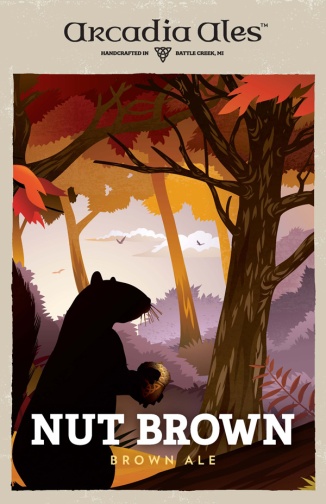 POURING A RUDDY brown with mild haze and a small fizzling head, Arcadia’s Nut Brown Ale is actually more toasty than nutty from the first aromas through the finish. A walnut shell dryness and texture do emerge towards the back end and hint at another layer of complexity, but their presence is not persuasive. The brewery also highlights dark berries, though if there is any fruit here it’s of the dried variety—actually verging on sour. Swirling the glass didn’t do much for the aroma, only seeming to make it more clinical and the finish almost brackish. Otherwise the body was a little thin, heavy enough on the dark toasted malts to verge on astringency. The color and overall character are light enough that the dry impression could come from oversparging instead of the malts themselves.
POURING A RUDDY brown with mild haze and a small fizzling head, Arcadia’s Nut Brown Ale is actually more toasty than nutty from the first aromas through the finish. A walnut shell dryness and texture do emerge towards the back end and hint at another layer of complexity, but their presence is not persuasive. The brewery also highlights dark berries, though if there is any fruit here it’s of the dried variety—actually verging on sour. Swirling the glass didn’t do much for the aroma, only seeming to make it more clinical and the finish almost brackish. Otherwise the body was a little thin, heavy enough on the dark toasted malts to verge on astringency. The color and overall character are light enough that the dry impression could come from oversparging instead of the malts themselves.
Munich or Caramunich seem apparent here, otherwise a little caramel and likely something roasted for that final edge of crispness at the finish. This is a little overdone.. The hop character was also constrained to a mild bitterness on the back of the tongue despite 35 IBUs. By no means high, of course, but some more pronounced earthiness, spice, or floral notes were expected from a beer in this category. Many of these qualms could stem from age, it should be noted, as this bottle appears to have endured some rough treatment. (On the other hand, perhaps age wasn’t so large a factor, since most of the traits noted here seem consistent with the general consensus.) Still there’s some peculiar appeal to the beer—perhaps that touch of tang at the end that encourages one to take another sip. But ultimately it lacks the balance to be appealing in the long run and the effervescence to be refreshing in the short—’real ale’ inspiration or no.
Served: 12 oz bottle
Rating: 71










 HAILING FROM CALIFORNIA, Lost Coast Brewery (not to be confused with The Lost Abbey, also from the Faultline State) was founded in 1990 by two women with a passion for English brewpubs. Fusing that European tradition with West Coast grains proved to be a winning proposition, and today the brewery’s beers can be found across half the nation. After the obligatory IPA, one of their best-known draughts is this, the Downtown Brown, though frankly it’s a little perplexing as to why. Pouring a modest tannish head on a nut brown body, the Downtown keeps right on by-the-numbers straight through till the end. Admittedly very smooth and round in flavor, nearly like a crème, with sweet, lightly toasted barley and caramel offset moderately by carbonation. Not too full on body, few hops to speak of, and all in all a bit one-dimensional, despite the cubist promise of its label. Sometimes homage just isn’t enough.
HAILING FROM CALIFORNIA, Lost Coast Brewery (not to be confused with The Lost Abbey, also from the Faultline State) was founded in 1990 by two women with a passion for English brewpubs. Fusing that European tradition with West Coast grains proved to be a winning proposition, and today the brewery’s beers can be found across half the nation. After the obligatory IPA, one of their best-known draughts is this, the Downtown Brown, though frankly it’s a little perplexing as to why. Pouring a modest tannish head on a nut brown body, the Downtown keeps right on by-the-numbers straight through till the end. Admittedly very smooth and round in flavor, nearly like a crème, with sweet, lightly toasted barley and caramel offset moderately by carbonation. Not too full on body, few hops to speak of, and all in all a bit one-dimensional, despite the cubist promise of its label. Sometimes homage just isn’t enough.